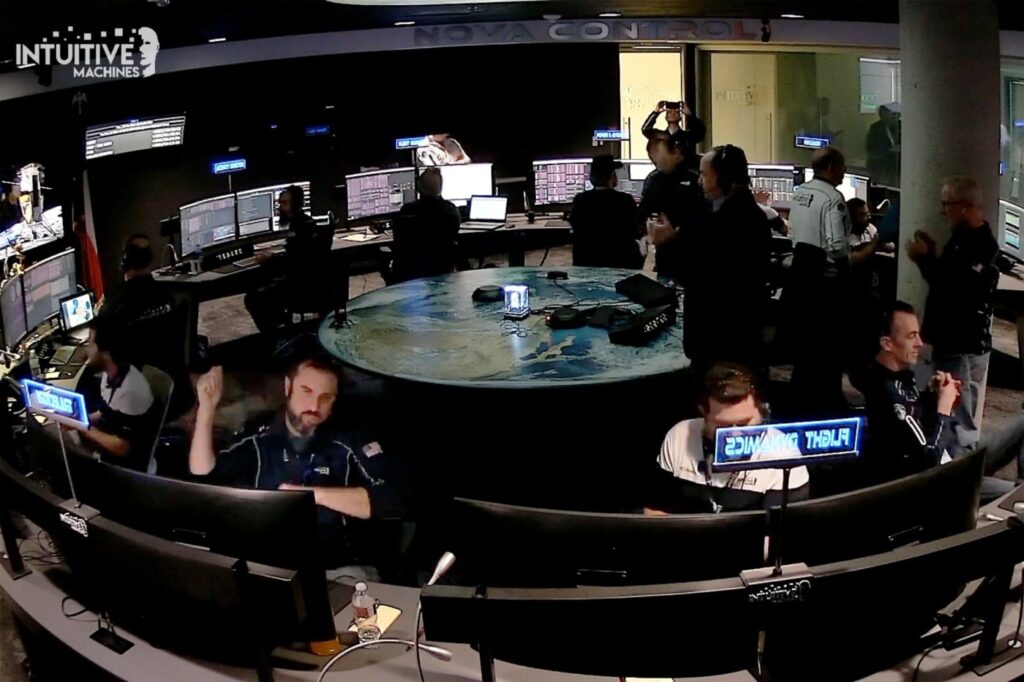
By MARCIA DUNN | AP Aerospace Writer
CAPE CANAVERAL, Fla. — A private lander touched down on the moon Thursday but managed just a weak signal back, as flight controllers scrambled to gain better contact with the first U.S. spacecraft to reach the lunar surface in more than 50 years.
Despite the spotty communication, Intuitive Machines, the company that built and managed the craft, confirmed that it had landed. There was no immediate word from the company on the condition — or even the exact location — of the lander. The company ended its live webcast soon after confirming a touchdown.
Mission director Tim Crain said the team was evaluating how to refine the lone signal from the lander, named Odysseus.
“But we can confirm, without a doubt, that our equipment is on the surface of the moon,” he said.
Added Intuitive Machines CEO Steve Altemus: “I know this was a nail-biter, but we are on the surface and we are transmitting. Welcome to the moon.”
This image provided by Intuitive Machines shows its Odysseus lunar lander over the near side of the moon following lunar orbit insertion on Wednesday, Feb. 21, 2024. (Intuitive Machines via AP)
The landing put the U.S. back on the surface for the first time since NASA’s famed Apollo moonwalkers.
Related Articles
Private lunar lander is closing in on the first US touchdown on the moon in a half-century
SpaceX on track Wednesday to launch Space Force mission in Florida, satellite payload in California
SpaceX accused of sexual harassment as fight with ex-employees intensifies
Astrobotic lander burns up in Earth reentry after missing shot at the moon while Japan celebrates success
Japan becomes 5th country to reach the moon after spacecraft lands on lunar surface
Intuitive Machines also became the first private business to pull off a lunar landing, a feat achieved by only five countries. Another company gave it a shot last month, but never made it to the moon, and the lander crashed back to Earth.
Odysseus descended from a moon-skimming orbit and guided itself toward the surface, searching for a relatively flat spot among all the cliffs and craters near the south pole.
Tension mounted in the company’s Houston command center following the designated touchdown time, as controllers awaited a signal from the spacecraft some 250,000 miles (400,000 kilometers) away. After close to 15 minutes, the company announced it had received a weak signal from the lander.
Launched last week, the six-footed carbon fiber and titanium lander — towering 14 feet (4.3 meters) — carried six experiments for NASA. The space agency gave the company $118 million to build and fly the lander, part of its effort to commercialize lunar deliveries ahead of the planned return of astronauts in a few years.
FILE – This photo provided by Intuitive Machines shows the company’s IM-1 Nova-C lunar lander in Houston in October 2023. The private U.S. lunar lander reached the moon and eased into a low orbit Wednesday, Feb. 21, 2024, a day before it will attempt an even greater feat _ landing on the gray, dusty surface. (Intuitive Machines via AP, File)
Intuitive Machines’ entry is the latest in a series of landing attempts by countries and private outfits looking to explore the moon and, if possible, capitalize on it. Japan scored a lunar landing last month, joining earlier triumphs by Russia, U.S., China and India.
The U.S. bowed out of the lunar landscape in 1972 after NASA’s Apollo program put 12 astronauts on the surface. A Pittsburgh company, Astrobotic Technology, gave it a shot last month, but was derailed by a fuel leak that resulted in the lander plunging back through Earth’s atmosphere and burning up.
Intuitive Machines’ target was 186 miles (300 kilometers) shy of the south pole, around 80 degrees latitude and closer to the pole than any other spacecraft has come. The site is relatively flat, but surrounded by boulders, hills, cliffs and craters that could hold frozen water, a big part of the allure. The lander was programmed to pick, in real time, the safest spot near the so-called Malapert A crater.
The solar-powered lander was intended to operate for a week, until the long lunar night.
Besides NASA’s tech and navigation experiments, Intuitive Machines sold space on the lander to Columbia Sportswear to fly its newest insulating jacket fabric; sculptor Jeff Koons for 125 mini moon figurines; and Embry-Riddle Aeronautical University for a set of cameras to capture pictures of the descending lander.
The Associated Press Health and Science Department receives support from the Howard Hughes Medical Institute’s Science and Educational Media Group. The AP is solely responsible for all content.
